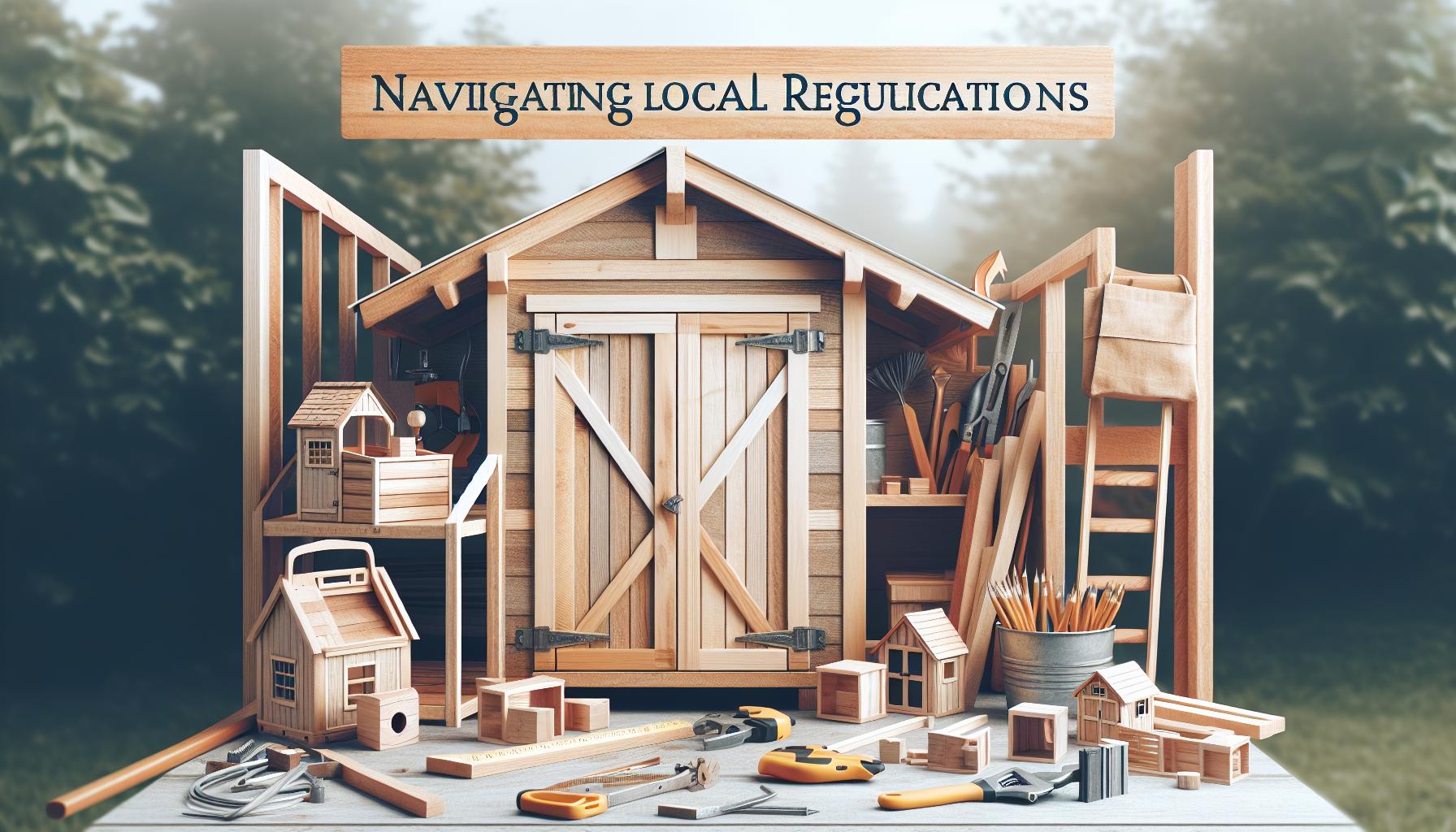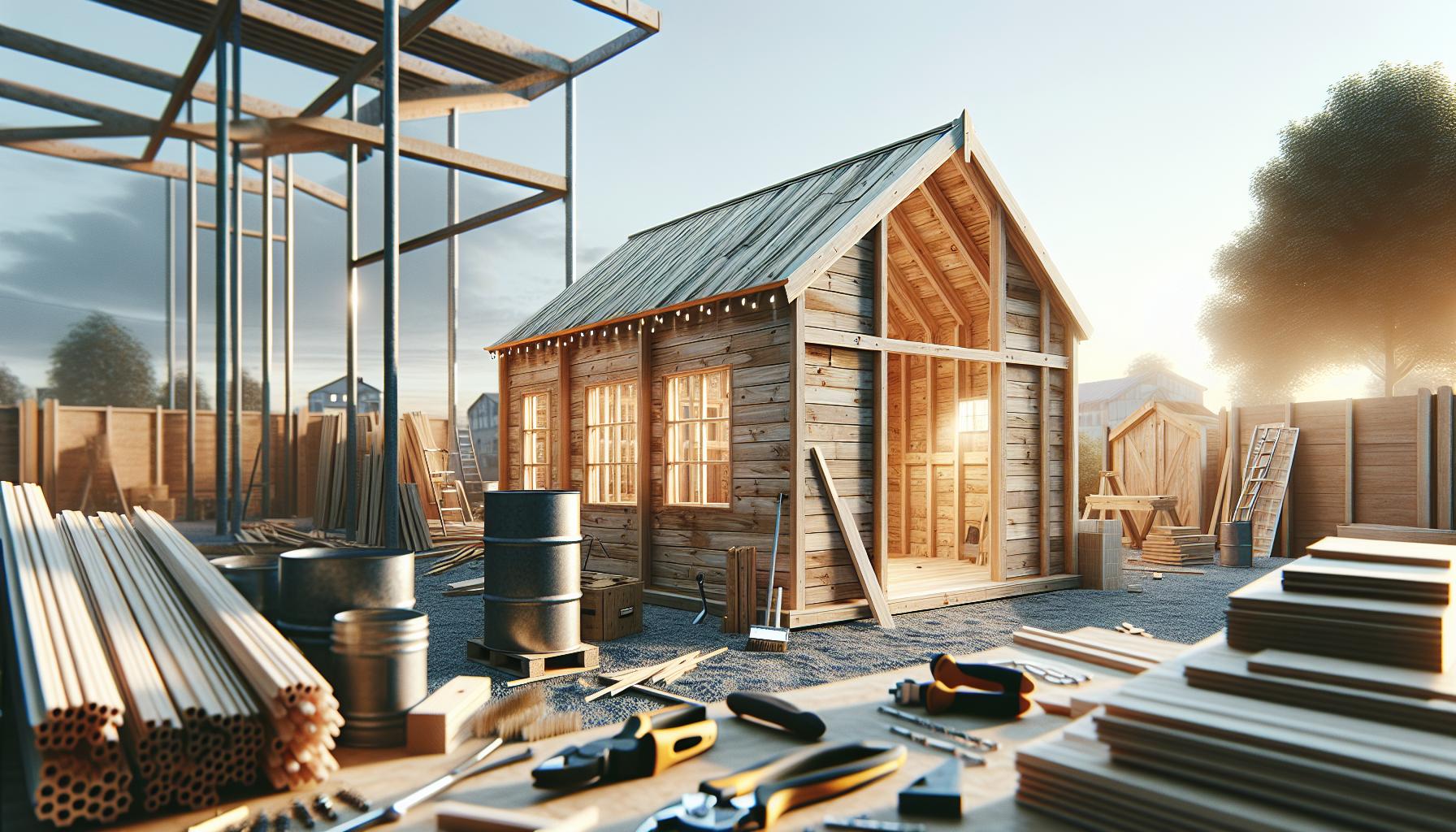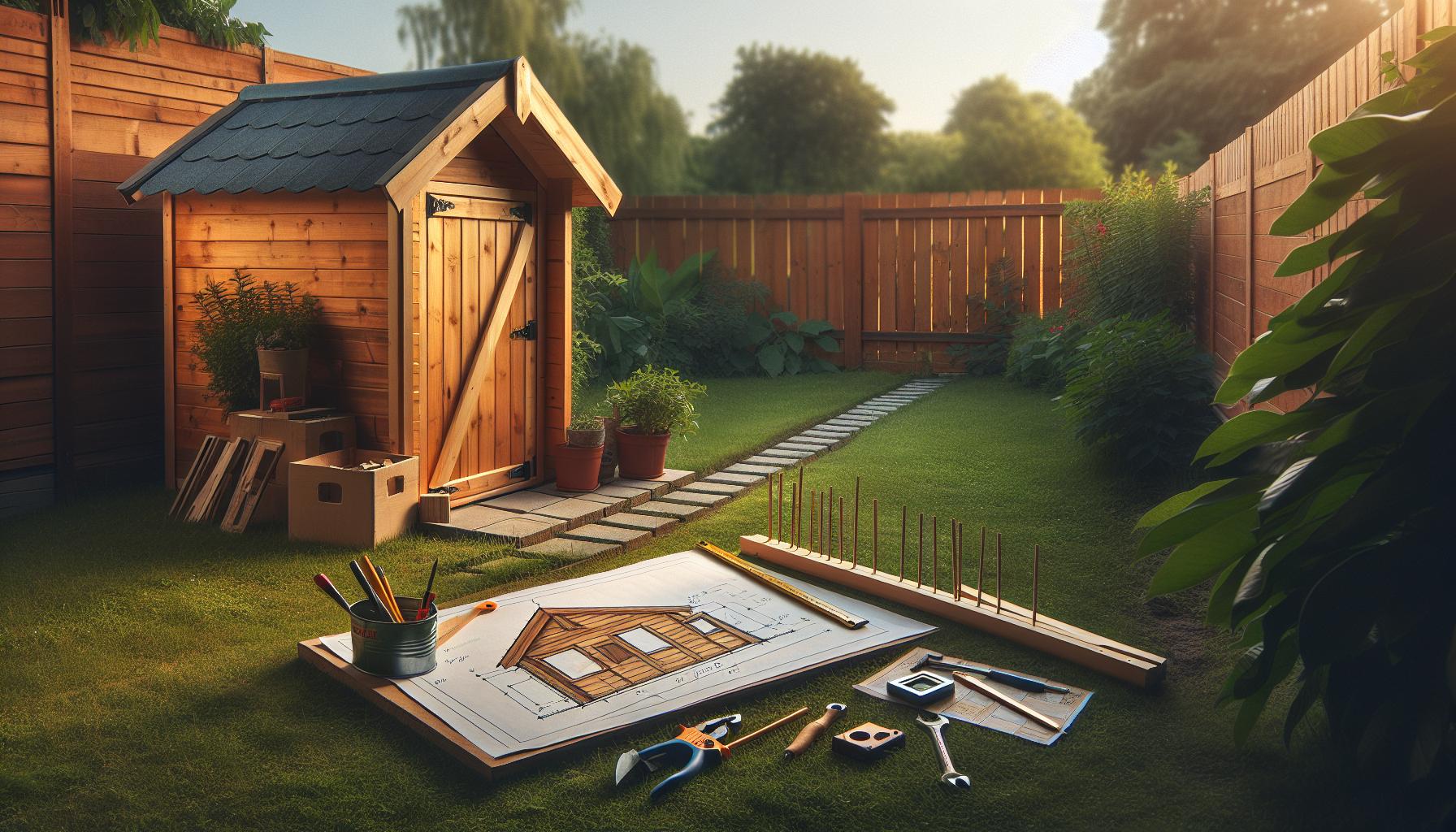Are you planning to build a shed but unsure if you need permission? Understanding the size limits and local regulations is crucial to avoid unexpected fines or construction delays. This guide will clarify when planning permission is required, helping you navigate the rules seamlessly while enhancing your outdoor space.
Understanding Planning Permission for Garden Structures
Understanding the nuances of planning permission for garden structures can dramatically influence your outdoor projects.Many homeowners are eager to enhance their gardens with sheds, offices, or othre structures, but a lack of awareness about legal requirements can lead to complications. Generally,many small garden buildings,such as sheds,fall under permitted progress rights,meaning they do not require planning permission. though, it’s crucial to familiarize yourself with the specific conditions that apply.
Key Considerations for Planning Permission
To determine if you need planning permission, consider the following criteria, which are essential in the context of your garden structure:
- Height Regulations: Most structures under 2.5 meters in height, measured from ground level, do not require permission. However, if your shed is within 2 meters of a boundary wall, it cannot exceed this height.
- Location: The placement of your structure is critical.Structures located in front gardens or areas where they would be prominently visible may necessitate planning permissions, regardless of other conditions being satisfied.
- Land Use: If your garden structure is intended for commercial purposes, a planning application is often required. Residential uses typically enjoy more leniency.
Examples of Structures Requiring Planning Permission
While many garden structures are classified as permitted development, there are scenarios where planning permission is needed. For instance, a larger garden office exceeding the specified height limits, or a garden structure that serves as a living space, often requires formal permission. To assist you, the following table summarizes common garden structures and their general permissions:
| Structure Type | Planning Permission Required? |
|---|---|
| Standard Garden Shed | No (if under height limits) |
| garden Office | possibly (depends on size and use) |
| Greenhouse | No (if under height limits) |
| Gazebo or Summer House | No (if under height limits) |
Adhering to the allowed dimensions and placement can save you from potential disputes with local authorities and ensure a smoother building process. Always check with your local council for any specific rules or changes, as these can vary substantially by location. By understanding the requirements outlined in “Do You Need Planning Permission for a Shed? Size Limits Explained,” you can confidently plan your garden improvements while staying on the right side of the law.
Size Limitations: What You Can Build Without a Permit
When considering the construction of a shed or similar outbuilding,understanding the legal size limitations can save you both time and hassle. Many property owners might be surprised to discover that they can construct a substantial structure without needing a permit. In Texas, for instance, the most common threshold is a maximum size of 200 square feet for unpermitted builds, provided there are no additional complexities like plumbing or electrical installations involved [[1]].
This size limit can vary significantly depending on the jurisdiction. For example, in some areas, you might only need to adhere to a 120 square feet limit if your project is intended to remain a simple structure without utilities. others may allow up to 160 square feet before requiring permits [[3]]. Thus, understanding your local regulations is essential before diving into any construction project.
Additionally, itS crucial to be aware of the specific restrictions regarding setbacks—defined distances that your building must maintain from property lines. This requirement can dramatically affect how you plan your shed’s location. as an example, even within the permissible size limits, you could find that optimal placement becomes restricted based on these rules, impacting the overall utility and accessibility of your space.
To summarize, while the allure of building without a permit presents an excellent possibility for DIY enthusiasts, it requires careful consideration of your local building codes and size restrictions. Engaging with local authorities or consulting a building professional can provide clarity, ensuring your project is both compliant and hassle-free.
Common Exceptions and Specific Rules for Sheds
Building a shed can be an exciting project, but navigating the regulations that accompany it can be daunting. While many outdoor structures are permissible under certain conditions, understanding the nuances is crucial for compliance and avoiding potential penalties. Regulations regarding planning permissions often hinge on factors such as size, location, and intended use.
Size Considerations
One of the most critical elements determining whether you need planning permission revolves around the size of the shed.Generally, smaller sheds—typically those measuring 6′ x 8′ or 8′ x 8’—are permissible without a permit in many jurisdictions.However, larger structures, particularly those exceeding 16′ x 20′, often trigger the need for formal approval. This size-sensitive rule applies across various regions, although specific measurements and regulations can differ significantly based on local laws. Always check with your local council to ascertain limits pertaining to your area.
Location Restrictions
Along with size, the location of your shed can also influence whether a permit is required. For instance, placing a shed too close to property lines or on public land can necessitate additional permissions or even lead to enforcement actions. Many areas have specific regulations outlining how far from boundaries your shed must be located.
Use and Utility
The intended use of the shed plays a critically important role in determining whether you need planning permission. For example, if your shed will house electrical installations or be used as a workspace, special permits are often required. Additionally, sheds utilized for commercial purposes tend to face stricter regulations than those designated for personal use. Always ensure that your shed complies with local zoning laws regarding its purpose.To summarize,understanding the common exceptions and specific rules regarding sheds can significantly impact your construction project. Ensure you’re well-informed by consulting local guidelines tailored to your area, especially when it comes to size limits and intended use. This approach not only ensures compliance but also enhances the longevity and utility of your new outdoor space.
The Importance of Location: How Your Shed’s Position Affects Permits
When considering the placement of a shed on your property, it’s essential to grasp how location can dramatically influence the need for planning permission.Not only can the distance from property lines impact compliance with local zoning laws, but various factors such as your regional climate, proximity to other structures, and even the main dwelling can determine whether permits are required.Understanding these regulations helps you avoid potential legal pitfalls and construction delays.
Key Factors in Shed Placement
The positioning of your shed matters significantly in terms of required permits. Here are a few critical factors to keep in mind:
- Setback Requirements: Most municipalities mandate that sheds maintain a certain distance from property lines. These setbacks frequently enough vary based on local zoning regulations. Failing to adhere to them can result in fines, or worse, the need to relocate or dismantle your shed.
- Building Height: The height of your shed in relation to neighboring structures can also influence permit requirements. Taller structures may be subject to more stringent regulations.
- Usage of the Shed: If your shed is intended for residential use, it may face more rigid guidelines compared to a purely decorative or storage shed.
- Environmental Considerations: In certain areas, such as near water bodies or protected land, local regulations may impose additional restrictions on placement to protect natural resources.
Real-World Examples
For instance, in many urban areas where space is tight, homeowners often face strict regulations regarding shed placement. In West Columbia, SC, for example, the local zoning requirements stipulate that accessory structures like sheds must be a minimum of 5 feet from property lines, and this can vary if the home is located on a corner lot or near roads [[3](https://westcolumbiasc.gov/building-permits/)]. Neglecting to check such rules can lead to significant and costly consequences.
The rules regarding the necessary permits for a shed can vary not just by city or state, but also within districts of a city. Therefore, reaching out to your local building department before moving forward with plans can save you time and money. Always be proactive in verifying whether your intended location adheres to local zoning laws and building codes to ensure a smooth shed installation process.
By recognizing the importance of location when evaluating whether you need planning permission for a shed,you not only stay compliant but also make informed decisions that enhance your property’s value.
navigating Local Regulations: Where to Find the Right Information
Navigating local regulations can be a daunting task, especially when it comes to understanding the rules surrounding structures like sheds. It’s essential for homeowners to be well-informed about whether they need planning permission for a shed, as this can vary significantly depending on local laws and property specifics. Seeking out the right information is crucial in ensuring compliance and avoiding potential fines or the need to dismantle your structure.
to start, local zoning laws play a pivotal role in determining what you can build on your property. these regulations dictate the permissible size, height, and usage of sheds. Typically, you can find this information by visiting your town or city’s zoning office website or directly contacting city hall. They can provide specific guidelines tailored to your locality, including size limits, distance from property lines, and other restrictions that might apply to your shed. Many municipalities have detailed planning documents available for download, which outline these requirements clearly.
Another useful resource is the local planning board or construction department, which often holds regular meetings where residents can learn about upcoming changes to zoning regulations. Attending these meetings can provide valuable insights, and you may have the opportunity to ask questions directly to city planners. Additionally, affiliated community forums and local homeowner associations may offer advice based on shared experiences among neighbors who have undertaken similar projects.
Practical Steps to Gather Information:
- Visit your local zoning office’s website for downloadable resources.
- Contact city officials directly for clarifications on specific regulations.
- Attend town hall meetings regularly to stay informed about planning changes.
- Consult with neighbors or local DIY groups for shared insights and experiences.
Understanding these local regulations not only helps you determine if you need planning permission for a shed but also ensures that the structure you plan to erect adheres to community standards, ultimately benefiting both your property value and the neighborhood’s aesthetic. Always remember that when in doubt, reaching out for clarification can save you time, money, and the headache of potential legal issues.
tips for DIY Shed Builders: Ensuring Compliance and Success
When embarking on the exciting journey of building your own shed, understanding the legal requirements is essential to avoid costly mistakes. Many DIY builders underestimate the importance of ensuring compliance with local regulations, but failing to do so can result in fines or the need to dismantle your hard work. knowing whether you need planning permission for your shed, especially considering the size limits, will help streamline your project and give you peace of mind.
Know the Size Limits
Understanding the dimensions that typically require a permit can save you time and effort. For instance, sheds measuring around 6’x8′ or 8’x8′ often do not require a permit, making them ideal for those who want to avoid bureaucratic delays. Conversely, larger structures, such as those over 16’x20′, are more likely to require permits and should be carefully evaluated against local codes to ensure compliance [[1]].
Check Local Regulations
Before you start construction, checking with your local governing body is crucial. Regulations can vary significantly by area, and some municipalities may have unique building codes that could affect your project. You should inquire whether there are specific requirements or permits needed based on your location. Certain regions may require even smaller structures to be permitted, especially if they are going to be electrical or plumbing installations [[2]].
Consider factors Beyond Size
While size is a primary consideration for planning permission, other factors, including the location of your shed on your property and its intended use, can also influence compliance requirements. Such as, if your shed is planned for residential use or is situated near property lines or designated wetlands, you may face additional restrictions. Gathering insights from your local zoning office can provide clarity on these nuances, ensuring that your project aligns with all necessary regulations [[3]].
Document Everything
To safeguard your investment and streamline future dealings, document all your research on regulations, permits applied for, and correspondence with local authorities. Keep receipts of permit fees and maintain a project file. This organizational step not only aids in demonstrating compliance but can also simplify any future renovations or constructions on your property. Creating a well-documented approach will serve you well and can enhance the overall success of your DIY shed project.
When to Consult a Professional: Knowing Your Limits
Understanding when to consult a professional can be a pivotal factor in the triumphant construction of your shed, especially regarding planning permission and size limits. While many homeowners feel confident enough to tackle DIY projects, understanding the intricacies of local regulations is crucial. Engaging with a professional can save you from costly mistakes and ensure your shed complies with local building codes, especially if your plans exceed the thresholds for permit exemption.
If your shed is larger than the allowable dimensions—typically around 120 square feet in California or depending on local regulations—it’s essential to seek professional advice. A building permit might be unavoidable,and the process can involve various steps such as site inspections and design reviews. Professionals can help navigate these complexities, ensuring that your application is complete and submitted correctly. Here are some scenarios where consulting a professional is advisable:
- Complex Designs: If you plan to build a shed that includes intricate designs or multiple levels, getting architectural support can enhance both functionality and aesthetics.
- Unique Locations: Building on sloped terrain or near property lines may require a thorough understanding of zoning laws and potential encroachments.
- Material Considerations: Using specific materials or advanced construction techniques may trigger additional regulations, which professionals can definitely help clarify.
Although understanding the basic size limits can empower you, the details often require a deeper dive. As a notable example, in some municipalities, any accessory structure over 64 square feet or with a height exceeding 15 feet will likely necessitate a building permit. This is where the expertise of a contractor or an architect can guide you effectively. They can also provide insights into how to maximize your shed’s potential while remaining within legal boundaries.
It’s not merely about compliance; a professional can help streamline the construction process, adopt sustainable practices, and possibly save you money over time through better planning. As you consider your shed project, reflecting on these factors will allow you to determine when it is prudent to bring in an expert to ensure your shed project aligns with both your vision and legal requirements.
Planning Ahead: How to Prepare for Potential Challenges in Shed Construction
When embarking on the construction of a shed, the excitement can frequently enough overshadow the planning process, yet careful preparation is crucial for a smooth building experience. Understanding the nuances of shed construction, particularly regarding planning permission, can save you from potential setbacks that might arise from legal complications or unexpected construction issues. before breaking ground on your project, it’s essential to familiarize yourself with local regulations, potential site challenges, and the necessary steps to mitigate issues during the build.
Research Local Regulations
One of the first steps in your planning process should be to dive deep into local building codes and zoning laws. Many municipalities have specific guidelines regarding the size, height, and placement of sheds on your property. As an example, in many areas, if your shed is smaller than 120 square feet, it may not require a permit; though, if it exceeds this limit, you will need to obtain one before construction begins [[2](https://www.reddit.com/r/shedditors/comments/1ee0zzr/los_angeles_shed_setback_rules/)].Moreover, researching regulations ensures that your shed adheres to setback requirements, which dictate how far your shed must be positioned from property lines and other structures.
Assess the Construction Site
Before you start laying the foundation, take the time to evaluate your construction site. Look for any potential challenges such as uneven terrain, proximity to trees, or existing structures that may interfere with access or aesthetic appeal. You should also consider drainage issues; sheds placed in low-lying areas might face flooding or water damage if not properly managed. A thorough site assessment can lead to strategic planning, allowing you to choose an optimal location and design for your shed, ultimately avoiding costly adjustments later.
Prepare for Common Challenges
Being proactive about possible challenges will save time and frustration. here are some common challenges and tips on how to address them:
- Weather Delays: Always check the forecast before scheduling construction days to avoid interruptions caused by poor weather. Have a flexible schedule in place to accommodate delays.
- Material Availability: Ensure that all building materials are sourced in advance.seasonal demand can lead to shortages,so order supplies ahead of time.
- Labor Resources: If you’re hiring professionals, secure their availability well before your projected start date to ensure your timeline remains on track.
By approaching your project with these considerations, you can effectively navigate the journey of building your shed and ensure compliance with local regulations. Ultimately, this preparation not only streamlines the construction process but also enhances the longevity and functionality of your new structure.
FAQ
Do You Need Planning Permission for a Shed? Size Limits Explained?
Yes, you frequently enough need planning permission for a shed, especially if it exceeds 120 square feet or local regulations require it regardless of size. Always check your local rules.
In many areas, sheds under 120 square feet can be constructed without planning permission, but this can vary. For instance,some regions might have stricter rules based on zoning laws or property type. It’s essential to consult your local zoning office for accurate information.
What Size Shed Can I Build Without Planning Permission?
You can typically build a shed up to 120 square feet without needing planning permission. Though, this limit can differ based on your local regulations.
Some jurisdictions may also allow sheds slightly larger, such as between 120 to 144 square feet, but you’ll need to check specific local building codes. Being informed about your community’s regulations can save you time and potential fines.
Can I Use a Garden Shed Without a Permit?
Generally, a garden shed under 120 square feet can be used without a permit, but conditions may vary.Always verify with local authorities.
Some states or municipalities have specific guidelines around the placement and intended use of garden sheds, particularly if they house animals or are used for commercial purposes. Understanding these nuances is crucial for compliance.
Why Does Size Matter for Planning Permission for Sheds?
The size of a shed directly influences whether you need planning permission as larger structures can affect neighbors and the local surroundings.
Sheds over 120 square feet may require detailed assessments, including their impact on light and privacy for surrounding properties. Smaller sheds usually pose less risk, making them easier to approve.
What Are the Consequences of Not Getting Shed Permission?
Not obtaining necessary planning permissions can lead to legal action, fines, or even the requirement to remove the shed.
Building without permission can create disputes with neighbors or local authorities, leading to increased costs and stress. To avoid complications, it’s best practice to check local regulations before starting your project.
Are There Any Variations in Shed Permit Requirements?
Yes, permit requirements can vary significantly across different jurisdictions and are influenced by local building codes and regulations.
Some areas may have maximum size limits or additional requirements based on property type (residential vs. commercial). Thus,researching specific local laws is crucial for any construction work you plan.
Can I Avoid Planning Permission by Building a Portable Shed?
While portable sheds are often exempt from planning permission, they can still require permits depending on their size and local laws.
If a portable shed exceeds 120 to 144 square feet, it’s advisable to confirm local permit requirements. _Portable_ does not always guarantee exemption from codes, so verifying beforehand is always the best approach.
To Wrap It up
When considering building a shed, understanding planning permission requirements is essential to ensure a smooth project. As detailed, planning permission often hinges on your shed’s size and the regulations specific to your area.Typically, sheds under 120 square feet may not require a permit, particularly smaller models like 6’x8′ or 8’x8′ frames. Though, anything larger, such as 16’x20′ or 16’x24′, frequently enough necessitates obtaining a permit, especially if it exceeds specific height restrictions [1[1,3].
Moreover, guidelines differ in various locations, so always check local regulations or consult with your planning authority before commencing construction [2[2]. By keeping these factors in mind, you can confidently plan your shed project without unexpected legal hurdles. Embrace the challenge of DIY construction,knowing that your careful preparation sets the foundation for success. for further insights and tips, continue exploring our resources to empower your building journey!









